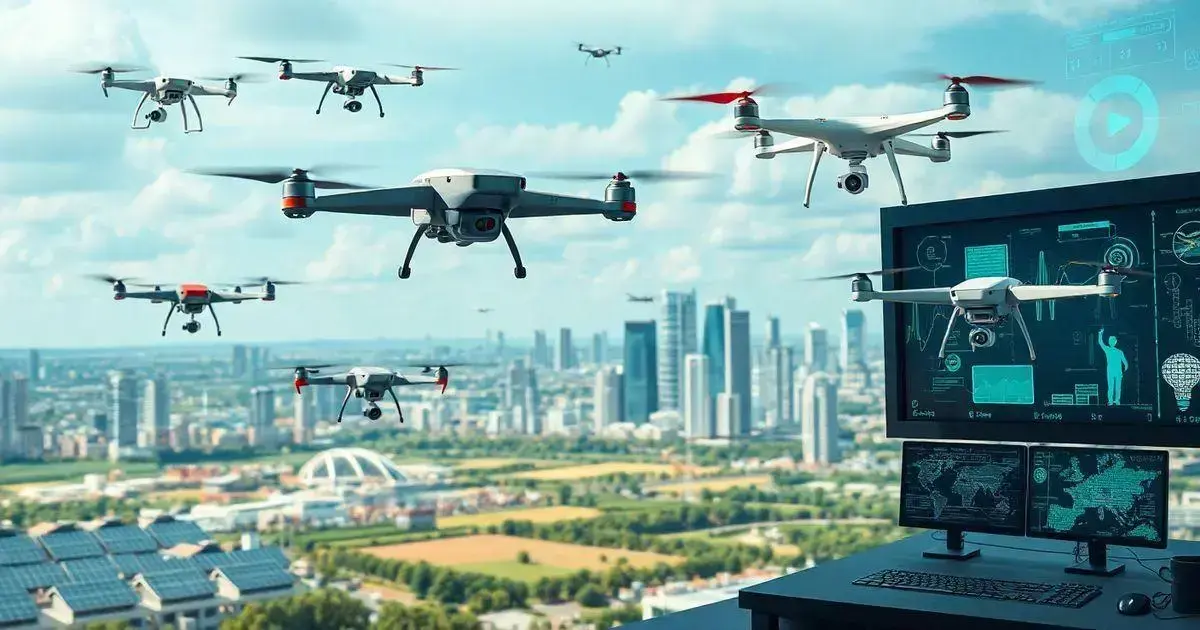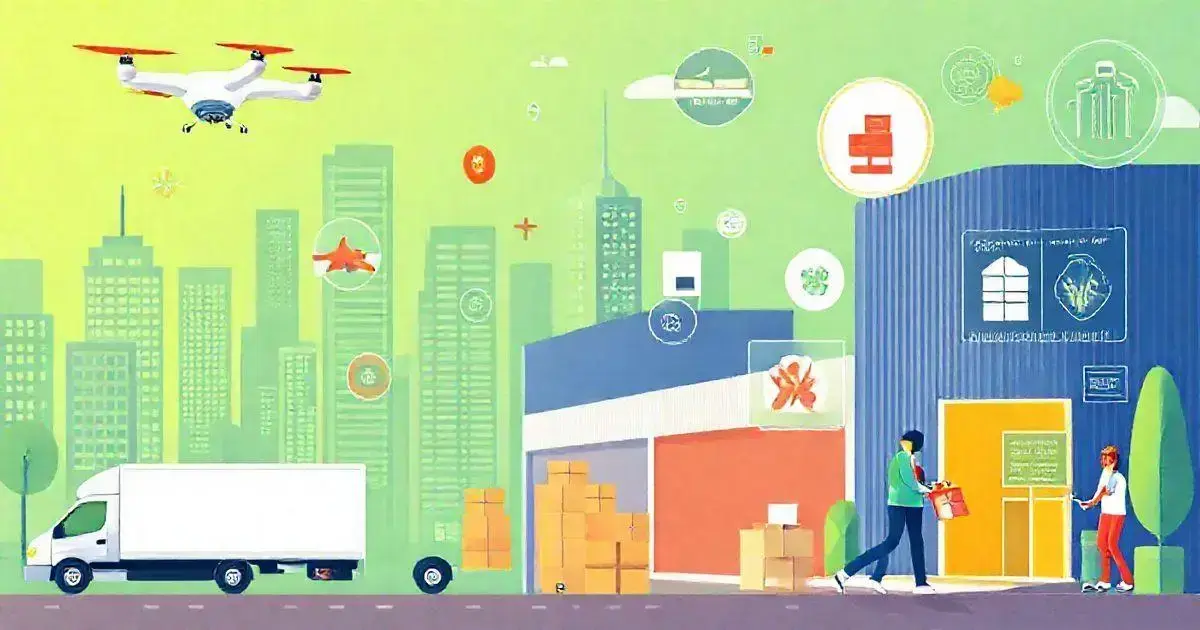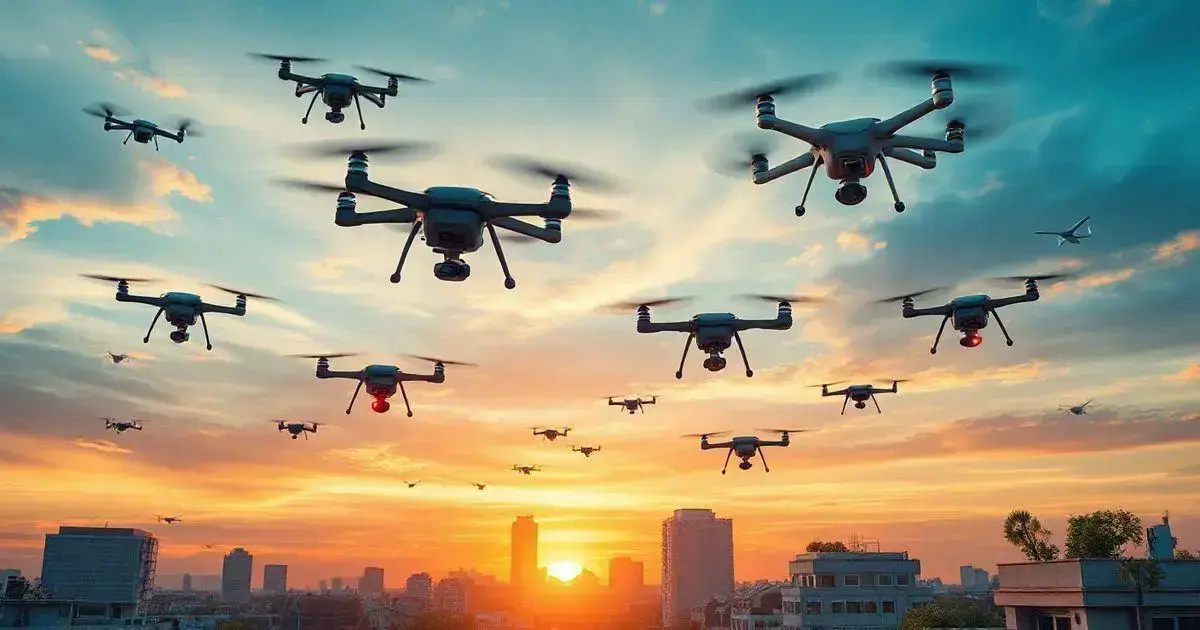The future of autonomous drones is a thrilling topic that captivates technology enthusiasts and industry leaders alike. These advanced machines are reshaping the way we view automation, offering new possibilities for both personal and commercial use.
Autonomous drones are not only transforming logistics and delivery services but are also poised to impact areas like agriculture, surveillance, and emergency response. Their ability to operate independently opens doors to greater efficiency and innovation across various industries.
Curious about what lies ahead for this groundbreaking technology? Keep reading to explore the current capabilities of autonomous drones, the challenges they face, and the exciting innovations set to revolutionize our skies.
Introduction to Autonomous Drones
Autonomous drones represent a significant advancement in aviation technology. These unmanned aerial vehicles (UAVs) are designed to operate without direct human control, relying on sophisticated navigation systems and artificial intelligence. They have a wide range of applications, including delivery services, agricultural monitoring, search and rescue operations, and environmental assessments.
One of the key benefits of autonomous drones is their ability to perform tasks efficiently and safely. For instance, they can access hard-to-reach areas, reducing the risk to human life during dangerous operations. Furthermore, with real-time data analysis, these drones can provide valuable insights that inform decision-making processes across various industries.
As we explore the landscape of autonomous drones, it is essential to understand the technology behind them. Most drones are equipped with GPS, complex sensors, and advanced software that enables them to navigate and complete their missions autonomously. Continued advancements in sensors and machine learning are expected to enhance their capabilities even further.
Current State of Drone Technology

The current state of drone technology has evolved rapidly over the past few years, bringing forth innovations and expanding applications across various sectors. Drones, often referred to as unmanned aerial vehicles (UAVs), are now equipped with advanced features such as high-resolution cameras, GPS navigation, and automated flight systems, allowing for more precise and efficient operations.
Today, drones are commonly used in fields like agriculture, where they enhance crop monitoring and management by providing real-time data that helps farmers make informed decisions. In the logistics industry, companies are experimenting with drone deliveries, helping to speed up the shipping process and reducing costs.
Moreover, the adoption of AI technology has improved drones’ ability to navigate complex environments autonomously. With these advancements, drones can be deployed in tasks such as search and rescue missions, construction site monitoring, and wildlife conservation efforts.
As regulations continue to evolve, the acceptance and integration of drones into everyday life is expected to grow significantly. This will pave the way for even more innovative uses of drone technology in the near future.
Challenges Facing Autonomous Drones
As the field of autonomous drones evolves, several challenges arise that impact their development and deployment. One of the primary hurdles is regulation. Governments worldwide are still working to establish clear guidelines for drone operation, which can create uncertainty for companies looking to innovate.
Another challenge pertains to safety. Drones must navigate complex environments, and there is always the risk of accidents, whether it’s crashing into objects or colliding with other aircraft. Ensuring safety in crowded or urban areas remains a significant concern that developers must address.
The technological limitations of current drones also pose challenges. Battery life, flight range, and payload capacity are all critical factors that determine the effectiveness of these machines. As demand grows for longer flights and heavier loads, technology must advance to meet these needs.
Furthermore, there are concerns regarding privacy and security. The use of drones for surveillance or data collection raises questions about who can access this information and how it is used. Public perception of drone technology also plays a role; without clear communication about their benefits and safety, acceptance may wane.
Ultimately, addressing these challenges is essential for unlocking the full potential of autonomous drones in various sectors, from logistics to emergency response.
Impact on Industries: Delivery and Beyond

The impact of autonomous drones on various industries is becoming increasingly evident. In the delivery sector, companies are utilising drones to transport packages quickly and efficiently. This technology not only speeds up delivery times but also reduces overall costs associated with traditional delivery methods.
In the agriculture industry, drones are transforming how farmers monitor crops and manage their fields. They can cover large areas in a short time, providing real-time data that allows for more precise interventions, such as targeted irrigation and fertilisation.
Moreover, the construction sector is using drones to conduct site surveys and inspections, which enhances safety and accuracy. Drones can capture high-resolution images and create 3D maps, streamlining the planning and monitoring processes.
In search and rescue operations, drones can reach disaster areas that are hard to access, offering vital support during emergencies. This capability can drastically improve response times and increase the effectiveness of rescue missions.
As industries continue to embrace autonomous drone technology, it is evident that these vehicles will play a crucial role in reshaping how we conduct business across multiple sectors.
Regulatory Landscape for Drones
The regulatory landscape for drones is crucial for the development and integration of autonomous technology into the airspace. Governments are working hard to create clear guidelines that ensure safety while promoting innovation. In many regions, drones are required to follow specific rules, such as maintaining certain altitudes and distances from people and structures.
One of the primary agencies involved in regulating drones is the Federal Aviation Administration (FAA) in the United States. They have established regulations that cover different categories of drone operation, from recreational use to commercial applications. This separation is important, as commercial drones often require more stringent measures due to the higher risks involved.
In addition to safety regulations, compliance with privacy laws is becoming increasingly important. Drones equipped with cameras and sensors can raise concerns about invasion of privacy, prompting governments to consider laws that protect citizens’ rights.
Another aspect of the regulatory landscape involves airspace management. As drone usage increases, the need for effective integration with manned aviation becomes vital. Systems are being developed to allow drones to communicate with air traffic control, ensuring safe cohabitation in busy airspaces.
Overall, understanding these regulatory challenges is essential for anyone looking to invest in or operate autonomous drones. Staying informed will help navigate the complexities and foster a responsible approach to drone technology.
Environmental Considerations

As the use of autonomous drones expands, environmental considerations are becoming increasingly important. Drones can play a significant role in monitoring and protecting our environment. For instance, they are being used in wildlife conservation efforts to track animal populations and monitor habitats without disturbing ecosystems.
Moreover, drones equipped with sensors can help in pollution monitoring. By capturing air quality data from various locations, they provide valuable information that aids in identifying sources of pollution and assessing environmental health.
In agriculture, drones are revolutionising sustainable farming practices. They enable farmers to assess crop health more accurately, helping to reduce the overuse of fertilizers and pesticides. This targeted approach results in less runoff into surrounding ecosystems, promoting a healthier environment.
However, as benefits increase, so do concerns. The potential for drones to affect wildlife must be addressed. If drones are flown near sensitive habitats, they could cause stress to animals and disrupt their natural behaviours. Regulations are needed to mitigate these impacts.
Therefore, while autonomous drones provide remarkable opportunities for environmental monitoring and protection, careful consideration must be given to their implementation to ensure they benefit the environment rather than harm it.
Future Innovations in Drone Technology
The future innovations in drone technology promise to enhance capabilities and expand the uses of these machines dramatically. Drones are expected to become more autonomous, with advancements in artificial intelligence allowing them to make decisions based on real-time data. This could lead to improved efficiency in delivery services and environmental monitoring.
One area of innovation includes swarming technology, where multiple drones can work together to complete complex tasks. For example, in agriculture, a swarm of drones could simultaneously monitor crop health across vast fields, providing more comprehensive data than a single drone could gather.
Furthermore, the integration of 5G technology will enhance drone operations by providing faster data transmission and improved connectivity. This will allow for real-time monitoring and control, making operations smoother and more reliable.
Another exciting development is the use of hybrid drones, which can switch between flying and driving. These versatile machines can navigate different terrains and broaden their applicability, such as in emergency response or search and rescue missions.
As the technology advances, it will be crucial to ensure that innovations focus on safety and sustainability. The future of drones is indeed bright, with countless possibilities on the horizon for their applications across various sectors.
Real-life Applications of Autonomous Drones

Autonomous drones have numerous real-life applications that are revolutionising various industries. In the agriculture sector, farmers use drones to monitor crop health through high-resolution imagery and data analysis. This allows them to identify areas needing attention and optimise resources, leading to more efficient farming practices.
In the logistics industry, drones are transforming the delivery process. Companies are testing drone deliveries to transport goods quickly and reduce delivery times, especially in remote or congested areas. This innovative approach is changing how businesses operate and serve their customers.
Drones are also making an impact in search and rescue operations. Their ability to cover large areas quickly and access hard-to-reach locations assists emergency responders in locating missing persons or assessing disaster-stricken areas efficiently.
In wildlife conservation, drones are used to track animal populations and monitor habitats. This technology offers an effective way to gather data without disturbing the animals, helping conservationists make informed decisions.
Overall, the potential applications of autonomous drones are vast and continually expanding, offering solutions that enhance efficiency and provide valuable data across various fields.
Frequently Asked Questions about Autonomous Drones
What are autonomous drones?
Autonomous drones are unmanned aerial vehicles that operate without direct human control, using advanced technology to navigate and complete tasks.
What industries use autonomous drones?
Various industries including agriculture, logistics, construction, and emergency services use autonomous drones for tasks like monitoring, delivery, and search and rescue.
How do drones impact agriculture?
Drones help farmers monitor crop health and manage resources more efficiently by providing real-time data on large areas.
What are the safety concerns with drone use?
Safety concerns include the risk of accidents, privacy issues, and the potential for drones to interfere with manned aircraft.
Are there regulations for flying drones?
Yes, regulations vary by country and often include guidelines for altitude, distance from people and structures, and training requirements for operators.
How can drones assist in emergency services?
Drones can quickly survey disaster areas, locate missing persons, and provide real-time information to emergency responders, improving response times.
What advancements are expected in drone technology?
Future advancements include better battery life, improved AI for autonomous decision making, and the integration of drones into urban air traffic systems.
Check out our article on Identify Fake News to learn how to spot misinformation and stay informed with credible sources.
